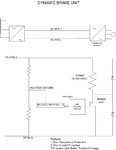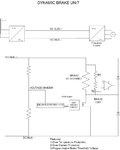hussain_kiet
Full Member level 5
- Joined
- Mar 15, 2007
- Messages
- 260
- Helped
- 45
- Reputation
- 90
- Reaction score
- 28
- Trophy points
- 1,308
- Location
- Karachi, Pakistan
- Activity points
- 2,802
Hi i want to sense the DC current passing through the IGBT..
I am attaching the block diagram of the circuit..
the problem i am facing is the voltage of the DC bus can go upto 1000 V and the current through the IGBT is over 2000A.. (seriously...)
so i need a perfect method to sense the current with isolation..
Note: I cannot add a small series resistance to measure its voltage & eventually the current because the power rating required for the series resistance is way high.
the possible method which i can see is to measure the Brake Resistance voltage then current.
can some body tell me how to measure brake resistance voltage with proper isolation..?
regards,
Hussain Aftab
I am attaching the block diagram of the circuit..
the problem i am facing is the voltage of the DC bus can go upto 1000 V and the current through the IGBT is over 2000A.. (seriously...)
so i need a perfect method to sense the current with isolation..
Note: I cannot add a small series resistance to measure its voltage & eventually the current because the power rating required for the series resistance is way high.
the possible method which i can see is to measure the Brake Resistance voltage then current.
can some body tell me how to measure brake resistance voltage with proper isolation..?
regards,
Hussain Aftab
Attachments
Last edited:

